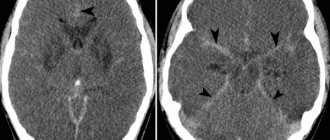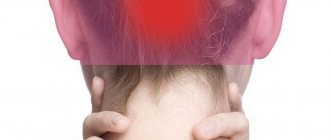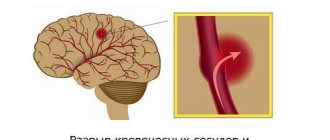Increased intracranial pressure in a child (arterial hypertension, intracranial hypertension) is a common disorder that can be a sign of various diseases. Intracranial pressure increases with brain tumors, hydrocephalus, neuroinfections (meningitis, encephalitis), intracerebral effusions, traumatic brain injuries, some hereditary pathologies and other diseases.
The development of arterial hypertension in a child is especially dangerous. Unstable pressure readings can cause serious abnormalities in brain development: mental retardation, blindness, paralysis and other pathological conditions.
Increased intracranial pressure is not always a sign of disorders. It can increase with everyday activities: defecation, coughing, stressful situations, suckling at the mother's breast, lifting heavy objects. It is not dangerous for the child. If intracranial pressure increases regularly and is permanent, parents and their child should seek medical help.
What is the essence of increased intracranial pressure?
The brain is washed externally and internally by cerebrospinal fluid (CSF). It nourishes, washes and protects brain structures from mechanical influences, maintains optimal intracranial pressure, and also regulates metabolic processes between blood and brain.
Liquor constantly circulates in the ventricles of the brain, inside the skull and other spaces of the spinal cord and brain. In certain areas, liquid accumulates, flows out and, having been distributed over other spaces, is absorbed back. There is a certain balance between the absorption and release of cerebrospinal fluid. If more fluid is released than is absorbed or less is absorbed than is released, or there are obstacles to the outflow of cerebrospinal fluid, the fluid begins to accumulate in a certain place, which causes intracranial pressure.
Since the brain is located in a closed cavity of the skull, the accumulated fluid begins to compress the brain, causing an increase in pressure. In this case, the child may experience episodic attacks of headaches.
Intracranial hypertension is not a rare case in infants. The cause of hypertension in a child from birth can be an intrauterine infection or hypoxia, neuroinfection, birth trauma, congenital defects or prematurity. Such children grow up with elevated levels of hypertension from an early age and get used to them, so they do not complain of headaches. The child may experience excessive excitability, lack of concentration and slow formation of certain mental functions (speech, walking, memory, writing, counting, logic, phonemic hearing). Therefore, if any disturbances in the functioning of the nervous system are detected, you should consult a doctor and undergo the necessary examinations.
Prolonged exposure of the brain to cerebrospinal fluid leads to its reduction. At the same time, the number of liquid cavities increases. This condition is called hydrocephalus. It is accompanied by partial replacement of brain matter with cerebrospinal fluid. In severe clinical cases, newborns experience a disruption in the development of nervous system functions and develop cerebral palsy (cerebral palsy). Severe hydrocephalus is treated with a brain shunt. In most cases, using osteopathic techniques, it is possible to get rid of this disease without surgery.
Signs of increased intracranial pressure in older children
In a child of an older age category, arterial hypertension is manifested by the following symptoms:
- Nausea, vomiting. Occurs against the background of irritation of the membranes of the medulla oblongata. The difference between vomiting in hypertension and vomiting in poisoning is that it does not bring relief.
- Pain behind the eyeballs. They are formed due to the effect of cerebrospinal fluid on the orbital area.
- The appearance of ribbons, flashes, double vision. This occurs as a result of irritation of the optic nerves.
- Attacks of headaches that get worse in the evening and at night.
- Restless sleep, irritability, tearfulness.
Why is unstable intracranial pressure dangerous?
The lack of appropriate treatment for hypertension can provoke the appearance of epileptic seizures and the death of certain parts of the brain due to oxygen deficiency. Chronic increased intracranial pressure, even with minor fluctuations from the norm, negatively affects the activity of the central nervous system. At the same time, signs of nervous exhaustion develop quite quickly, such as sleep disturbance, irritability, fatigue, as well as a decrease in intellectual and physical activity.
The greatest danger with unstable pressure is congestion in the optic discs, which can cause atrophy of nerve tissue, a sharp drop in vision and even complete uncorrectable blindness.
High blood pressure in young children: symptoms of the disease
Increased intracranial pressure can be manifested by the following pathological disorders and symptoms:
- Severe crying, restlessness. A distinctive feature of unstable intracranial pressure is that throughout the day the child may feel well and be relatively calm. In the evening and at night the baby begins to cry and becomes restless. This is due to the anatomy of the cerebrospinal fluid and venous systems. The baby lies down more at night and in the evening. As a result, venous outflow slows down, and the veins of the skull and brain become congested. As a result, the volume of cerebrospinal fluid increases, which provokes the development of arterial hypertension.
- Difficulty falling asleep, frequent waking up, sleep disturbance. The listed symptoms are also due to the structure of the venous and cerebrospinal fluid systems.
- Nausea, attacks of vomiting, profuse, frequent regurgitation. These clinical manifestations are reflex. High intracranial exposure provokes irritation of the membranes of the medulla oblongata, which is responsible for nausea and vomiting. It should be borne in mind that frequent regurgitation in a child can be caused by swallowing air during feeding and overfeeding. Therefore, it is not recommended to draw conclusions about intracranial hypertension based on symptoms alone. However, this pathology cannot be excluded either.
- Increase in head volume. The accumulation of cerebrospinal fluid in the cerebrospinal spaces can lead to divergence of the sutures of the cranial bones, enlargement of the frontal part of the skull, enlargement of the fontanelles and disproportionate size of the head.
- The appearance of a venous network under the scalp. With hypertension, excessive filling and stagnation of blood occurs in the venous network. This provokes expansion of the saphenous veins, which makes them visually noticeable.
- Graefe's symptom. It manifests itself as a dysfunction of the oculomotor nerves, which occurs against the background of birth trauma or high blood pressure. The eyeballs periodically begin to deviate downward, and the sclera becomes visible between the upper eyelid and the edge of the iris.
- Refusal to feed. In infants, intracranial pressure physiologically increases, which leads to increased pain. The result of refusal to feed a child is a lack of weight gain.
Disturbances in psycho-emotional and physical development. This can be caused by insufficient feeding and the presence of damaging factors on the brain.
Treatment of increased intracranial pressure with osteopathy
Living with hypertension for a child is unpleasant and harmful to health.
Under the influence of increased compression, brain structures cannot function normally. This causes atrophy of the white brain fluid, followed by a decrease in intellectual abilities and dysregulation of internal organs. To avoid the above complications, treatment of hypertension should begin as early as possible. To alleviate the child’s condition and normalize intracranial pressure, it is important to restore the balance between the absorption and production of cerebrospinal fluid. Traditional medicine uses diuretics for this. Osteopathy treats arterial hypertension in children using safe manual techniques that normalize the level of cerebrospinal fluid without surgery or drug therapy. Osteopathic techniques are aimed at unloading the venous bed of the head and eliminating pinching of blood vessels by the vertebrae.
about the problem
Intracranial pressure (ICP, intracranial hypertension) is an increase in pressure in the cranial cavity.
Inside the skull there is a liquid (cerebrospinal fluid), which is formed from arterial blood and washes the brain, circulating through special liquor pathways, then is reabsorbed into the bloodstream.
Increased pressure inside the skull occurs when there is more cerebrospinal fluid in the skull than normal. Excess cerebrospinal fluid is formed when its production is increased, or when there are obstacles to its free outflow.
The outflow of cerebrospinal fluid is hampered due to stagnation in the veins of the head and spine, where it should normally be absorbed. Accumulating in the cranial cavity, cerebrospinal fluid puts pressure on the soft tissues of the brain.
The cause of cerebrospinal fluid retention is often spasmed neck muscles and displaced cervical vertebrae, which compress the vessels that ensure the outflow of blood and cerebrospinal fluid from the cranial cavity. Muscle spasm and displacement of the vertebrae occurs with various injuries to the neck and head, most often birth injuries (subluxation of the atlas), cervical osteochondrosis.
In a child, symptoms of intracranial pressure (ICP) after a birth injury may appear and increase gradually several months after birth. The baby develops: anxiety, sleep disturbances, increased sweating, an unreasonable rise in temperature and shuddering. The child may “goggle” his eyes, or a slight squint may appear. With anxiety, there is trembling of the chin and arms, blueness or redness of the head or sharp marbling of the skin, and sometimes a short-term cessation of breathing occurs. During sleep, the child throws his head back, falls asleep better and sleeps in his arms, rubs his head or rocks it back and forth.
An adult with intracranial pressure may be bothered by: headaches; short-term and mild dizziness; frequent vomiting that does not bring relief; intraocular pressure; decreased vision; feeling of a “heavy” head; constant fatigue; congestion or noise in the ears; hearing loss; irritability; depressive states.
Long-term intracranial pressure over the years leads to atrophy of the cerebral cortex and severe dysfunction of the central nervous system.
Osteopathic approach to the treatment of intracranial pressure in a child
Osteopathic methods in the treatment of arterial hypertension in children are successfully used in cases where high intracranial compression of brain structures is caused by impaired venous blood circulation.
During osteopathic treatment, three mechanisms are simultaneously activated to improve the outflow of blood from the cranial cavity:
- Restoring the patency of venous vessels at the points of their exit from the cranium and in the area of the neurovascular bundle;
- Impact on parts of the nervous autonomic system;
- Normalization of the suction functions of the chest.
Also, the use of these methods makes it possible to achieve effective results in the complex treatment of arterial hypertension in the absence of indications for surgical intervention. In this case, the osteopath uses manual techniques aimed at restoring the craniosacral rhythm.
The course of osteopathic treatment and the number of manual therapy sessions are determined by the doctor, taking into account how old the child is and what symptoms accompany the disease. The positive effect of osteopathy treatment is visible after just a few sessions.
To achieve stable and long-term results in the treatment of increased intracranial pressure, osteopathic techniques are recommended to be combined with other conservative methods (physiotherapy, therapeutic exercises, adherence to eating and drinking regimes).
our treatment
Our center provides treatment aimed at eliminating the causes that lead to increased intracranial pressure.
We eliminate spasms of the neck muscles, realign displaced cervical vertebrae, and restore the normal outflow of venous blood and cerebrospinal fluid from the cranial cavity.
Effective treatment methods have been developed for all age groups.
Children receive specialized treatment using a patented orthopedic product (Patent No. 2587960).
To eliminate ICP in adults after injuries to the skull and cervical spine, after head contusions and concussions, or in the presence of osteochondrosis, we use our own patented treatment method (Patent No. 2571234).
If necessary, osteopathic sessions are prescribed to restore correct biomechanics in the cervical spine.
Diagnostic methods
A unique and most reliable way to measure the intracranial pressure on the patient’s brain in a few minutes is a puncture of the cerebrospinal fluid: a special puncture is made and a catheter is inserted into the lower back or into the brain. CSF flows out under pressure and measurements are taken. The normal value is from 60 to 200 mm of water column in a supine position.
There are also indirect studies:
- The ultrasound radiation method is carried out exclusively for babies whose fontanel has not yet fused and the brain is visible through the sensor;
- A method of computed tomography or magnetic resonance imaging, where the image shows the brain in full three-dimensional layout;
- The echoencephalography method allows you to determine the coefficient of filling and beating of arteries in the brain;
- Rheoencephalogram method - examines the outflow of blood from the veins in the vessels of the brain;
- X-ray - used for a sluggish diagnosis of hydrocephalus, mostly performed in adults and children over one year of age.
Symptoms of spasms in children
As mentioned above, the most common cause of spasms in children is pathology of the gastrointestinal tract.
Below we consider the main symptoms of gastrointestinal diseases accompanied by spasms in children:
- Intestinal colic. This pathology is characterized by sudden and severe bouts of crying in the baby. Colic appears during the neonatal period. Intestinal colic is associated with immaturity of the nervous regulation of intestinal activity and increased gas formation against the background of intestinal dysbiosis.
- Functional diarrhea and constipation. Spasms in these pathologies are not the main symptom. They can only appear periodically. The diseases are functional disorders of young children, which are accompanied by diarrhea or constipation, respectively. At the same time, an in-depth examination does not reveal any other pathology.
- Acetonemic syndrome. Often occurs in children, especially during early childhood. As a rule, the cause of its development is an error in diet. Other reasons include ARVI, harmless excitement (birthdays, etc.), stress. In this case, the pain is no longer caused by spasm, but by irritation of the mucous membrane with ketone bodies (those substances that cause acetone syndrome). Characteristic symptoms of this disease are the smell of acetone in the exhaled air, nausea, vomiting, lethargy, and drowsiness.
- Biliary dyskinesia, inflammation of the gallbladder . Dyskinesia is a functional disorder of the gallbladder and bile ducts, which may be accompanied by spasms in these organs. As a result, children experience pain, often in the right hypochondrium. In addition, children feel heaviness in the right hypochondrium, bitterness in the mouth, and yellowness of the skin and eyes appears.
- Gastritis and peptic ulcer. The causes are often Helicobacter pylori. Children experience: nausea, often vomiting, abdominal pain, heartburn, tendency to constipation, bad breath.
With gastritis, children often experience nausea, vomiting, and abdominal pain.
- Malabsorption syndrome . Among the pathologies in this group, it is worth highlighting celiac disease and lactase deficiency. Celiac disease is a gluten intolerance that is accompanied by a variety of symptoms, including abdominal pain. Lactase deficiency is an intolerance to dairy products, after consuming which occurs bloating, abdominal pain and diarrhea.
- Inflammatory bowel diseases. These include Crohn's disease and ulcerative colitis. It is most often characterized by the appearance of blood in the stool and abdominal pain. Subsequently, symptoms intensify and other signs appear.
- Intestinal infections. Acute intestinal infections are manifested by fever, often vomiting and diarrhea, which is characterized by persistent progression. As a rule, it can develop after eating bad foods or after contact with a sick person.
In addition to pathology of the gastrointestinal tract, other diseases can lead to the development of spasms and pain. Urinary tract infections are quite common, especially in girls. This is due to the short and wide urethra, through which pathogenic bacteria can quickly penetrate. The development of cystitis is accompanied by the appearance of symptoms such as pain when urinating, pain, frequent urination, burning and pain in the urethra and bladder. Teenage girls often develop dysmenorrhea, which is characterized by pain and heaviness in the lower abdomen.









